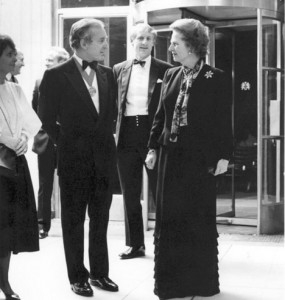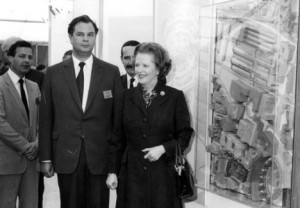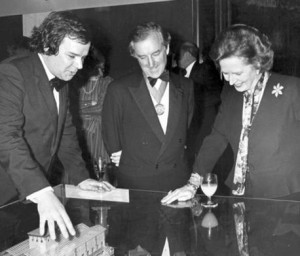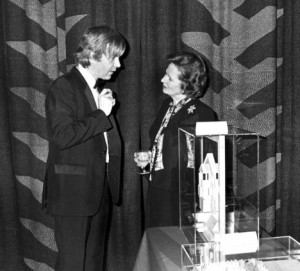Thatcher is a divisive figure among architects, but there’s no denying her impact on the architecture profession was huge Former Conservative prime minister Margaret Thatcher died this morning following a stroke. Her term as PM, from 1979 to 1990, heralded massive social and industrial change for the UK. Her policies, and decisions made during her tenure, also had a major impact on the architecture profession – some good and some bad.

1/ Privatisation of local authority services In the 1970s most of the biggest architecture practices in the UK were part of the public sector – architects’ departments within local authorities and the health service. Under Thatcher, the vast majority of these services were closed or privatised, with their work soaked up by private architecture, planning and engineering companies which have since become some of the biggest in the world. Less than one in three local authorities currently employ architects as architects. Meanwhile, architecture has become one the UK’s greatest exports. Margaret Thatcher was not popular with architects but she gave up more time to the profession than any of her successors, according to BD’s archive, which is bulging with photographs from her 11 years at Number 10. This photograph was taken on the occasion of Michael Manser’s inaugural reception as RIBA president in 1984 and also coincided with the RIBA’s 150th anniversary. Thatcher had just arrived at Portland Place and was introduced to Manser by the cabinet secretary Robin Butler, who can be seen standing between the two, while Manser’s wife José is just to the left of the picture. The occasion was a great success, recalls Manser: “She gave us a huge fillip.” To mark the occasion the RIBA had been decked out in green foliage and white flowers and was lit by 500 candles. Guests included several dukes and captains of industry and there was supper afterwards. “She was dashing,” says Manser of the former prime minster, “with a mind like a laser.”

2/ The Monopolies & Mergers Commission Although the Monopolies Commission came into existence before Thatcher became prime minister, its decision to declare mandatory minimum fee scales “anti-competitive” was made at the beginning of her first term. This was compounded by an Office of Fair Trading ruling a few years later. Described by one architect as “probably the worst thing to happen to our profession”, the declaration forced all professional bodies in the UK to withdraw official fee scales. Further rulings now prevent the RIBA from publishing even recommended or suggested fees. Margaret Thatcher with Stuart Lipton.

3/ Deregulation of the city – the Big Bang One of the key moments of Thatcher’s career was the Big Bang – the moment in October 1986 when her controversial deregulation of the UK’s stock exchange and financial services sector took effect, changing banking forever. Wide-sweeping reforms were introduced in an attempt to re-establish London as a financial centre and make its market more competitive in an increasingly global market. This deregulation created a need for more office space and huge trading floors in London, sparking a flurry of new building in the City. It also created a whole new cultural approach to money, with yuppie culture and a desire to spend giving birth to, or indirectly supporting, a number of new design movements. Will Alsop explains his scheme for Riverside Studios at Hammersmith to RIBA president Michael Manser and PM Margaret Thatcher. Under Thatcher’s government, the very concept of state funding for the arts came under attack, and everything from abstract sculpture to socially critical plays was condemned both for content and as a “drain on the public purse”. So it was perhaps no surprise that Hammersmith & Fulham Council abandoned the scheme only days later.

4/ Canary Wharf Founded by Thatcher’s Government in 1981, the London Dockland Development Corporation was charged with the total revitalisation of eight square miles of London that had once been thriving docks. As the focus of the country’s wealth moved from manufacturing to financial services, the Corporation’s first large-scale development plan was unveiled. The Canary Wharf project – the then largest single commercial development in the world – formally began in 1988 with an inaugural speech by Thatcher. Although much of the Canary Wharf area’s real boom took place in the late 1990s with the introduction of public transport links, it is still one of the most potent architectural symbols of Thatcherism. The architects that benefited directly include Cesar Pelli, John McAslan, SOM and Norman Foster. Simon Jenkins described the development as “big, bland and bankrupt”. Jeremy Dixon pictured with Margaret Thatcher at Michael Manser’s inaugural reception as RIBA president in 1984. Thatcher looks almost benign, listening intently to Dixon who is explaining the model, which he made himself for the 1982 Venice architecture biennale. It was an architectural self-portrait based on the facade of his housing at St Mark’s Road in west London.

5/ Right to Buy Very little publicly-funded housing was commissioned under Thatcher, but she did introduce Right to Buy for council tenants, effectively removing thousands of properties from the social housing system. Right to Buy heralded the end of an era in social housing design and the gentrification of large swathes of London in particular, with knock-on effects for architects working in both social housing and home improvement. Housing architects everywhere are still awaiting the opening of the social housing floodgates with bated breath. Zaha Hadid explains her competition-winning proposal for The Peak in Hong Kong to Margaret Thatcher – 1984.






